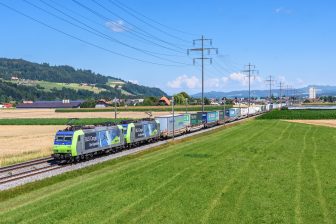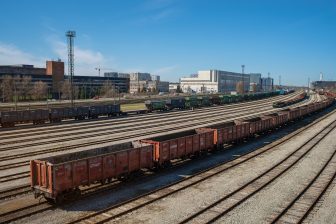
Intermodal up but UK rail freight down overall
Rail freight volumes in the UK towards the end of 2016 were down almost three per cent on the same period for 2015, new figures show. The Office for Rail and Road (ORR) says 4.42 billion tonne kilometres of freight was moved in the third quarter (Q3) covering the period between October-December, with some notable increases.
The construction and domestic intermodal sectors accounted for nearly two thirds of total freight moved, both rising year-on-year, with domestic intermodal setting a new record for the highest amount of freight moved since the quarterly measurements were introduced in 1998/99, with 1.72 billion tonnes.
Biomass down
Coal transported fell to 0.46 billion net tonne kilometres while ‘miscellaneous’, which includes biomass materials, also saw a drop to 0.42 billion tonnes. Five out of seven commodities however saw year-on-year increases, including metals (up 6.6 per cent to 0.11 billion tonnes) and oil & petroleum (up 0.6 per cent to 0.29 billion tonnes).
Freight delays increased in Q3 to 12.2 minutes per 100 train kilometres, up 1.7 per cent on 2015/2016 Q3. The total freight train kilometres travelled was 8.63 million km, down 0.2 million (-2.5 per cent) on the previous Q3.
Residential work
The ORR said there were many possible reasons for the trends seen, with the rise in construction materials for example ‘largely due’ to an increase in residential work, with more construction materials moved by rail in Q3. “Domestic intermodal showed an increase this quarter compared with the same quarter last year due to the growth in consumer focused service industries such as retail services,” it added.
The total amount of freight ‘lifted’ in Q3 was 20.8 million tonnes, down sharply by 9.6 per cent on the previous Q3. Unlike freight per se, this category measures the mass of goods carried in tonnes, excluding the weight of the locomotives and wagons, and takes no account of the distance travelled. The amount of coal lifted was 3.4 million tonnes, a big fall of 43.4 per cent compared to the same quarter last year.
Three operators recorded an increase this quarter compared to same period last year; Freightliner Heavy Haul with 0.75 million kilometres (up 6 per cent), GB Railfreight (GBRf) with 1.32 million kilometres (up 3.1 per cent), and Freightliner Intermodal with 2.18 million kilometres (up 0.9 per cent).
Better security
In the international category, better security at the Port of Calais was said to have helped increase the flow of freight in and out of the ferry terminal, resulting in an upturn in international rail freight traffic compared to the previous Q3.
On renewables, the ORR said: “The removal of the climate change levy exemption for renewable source electricity from power stations that use renewable source electricity is gradually feeding through as freight operators renew their supply contract, with possibly less orders for this freight in the other category this quarter compared same quarter last year.
Emissions
“The decision to phase out coal-fired power stations in order to reduce carbon dioxide emissions continues to affect the amount of coal freight moved by rail this quarter compared to same quarter last year,” it added.
From a peak of 455,561 freight train movements and freight lifted in 2005/06, there has been a steady decline, which the ORR says has been influenced by a mirrored decline in some traditional industries.
Fewer trains
“The reductions over time could be due to improved utilisation of freight capacity as the levels of freight being lifted and moved in the four year prior to 2015-16 were similar to those in the mid-2000s but with much fewer trains,” it said.
“In 2015-16, the number of freight movements decreased by 16.3 per cent compared to last year, from 282,304 to 236,290. The likely reason for the fall in 2015-16 is the fall in the use of coal in coal powered plants and closure of steel plants, with less coal and steel required to be carried by rail.”
The figures are available in full from the ORR website.





